The Origins of Luge Racing
Luge racing, a thrilling winter sport, traces its roots back to ancient civilizations. Early historians believe that the sport’s precursor possibly emerged with the practical needs of the indigenous peoples of Scandinavia and the Alps, who used sleds as a means of winter transportation. However, modern luge racing as we know it began to take shape in the 19th century, reflecting both cultural evolution and technological innovation.
Development in Switzerland
By the mid-1800s, the sport started to gain significant popularity, particularly in Switzerland, a country well-known for its alpine landscapes and winter sports culture. It was during this period that luge started to transition from a practical mode of transportation to a recreational and competitive endeavor. The world’s first organized luge race occurred in 1883 and represented a milestone for winter sports. The course, which spanned from the Swiss village of Davos to the town of Klosters, not only provided a challenging course for racers but also set a precedent for organized luge events in Europe and beyond.
This inaugural race undoubtedly captured the imagination of both participants and onlookers, serving as a keystone that would inspire the growth of competitive luge racing throughout the continent. The enthusiastic reception of this event revealed a broader interest in the development of winter sports and encouraged the establishment of more tracks, paving the way for the sport’s formal recognition.
Formalization and Recognitions
The next significant development for luge racing was the formalization of the sport through the establishment of governing bodies. In 1923, the International Luge Federation (Fédération Internationale de Luge de Course or FIL) was founded with the express purpose of standardizing the sport’s rules and regulations. The creation of the FIL was instrumental in formalizing luge as an internationally recognized competitive sport. This transition was critical, as it ensured that competitions were conducted under uniform standards, fostering fair play and enhancing the sport’s integrity.
The formation of the FIL also facilitated international competitions, allowing athletes from different countries to compete on a level playing field. This was a crucial development in the history of luge racing, as it helped to promote the sport globally, elevating its profile and attracting a broader base of participants and fans.
Luge in the Winter Olympics
The inclusion of luge racing as an official Olympic sport at the 1964 Winter Olympics in Innsbruck, Austria marked a landmark moment. It not only elevated the sport’s prestige but also expanded its reach and visibility on a global platform. The addition of luge to the Olympic roster brought the sport into the homes of millions, fostering a new generation of fans and aspiring athletes.
Since their inception in the Olympics, the luge events have consistently featured three main competitions: men’s singles, women’s singles, and doubles. This format has provided a consistent framework for competition, allowing for both individual endeavors and team-based dynamics in the doubles events. The Olympic spotlight has also driven many countries to develop robust training programs and facilities, further enhancing the competitive landscape of the sport.
Technological Advancements
Over the subsequent decades, technological advancements have played a pivotal role in the evolution of luge racing. Innovations have transformed the sport, making it faster, safer, and more strategically complex. Developments in sled design have been particularly impactful; modern sleds are aerodynamic marvels that minimize air resistance and maximize speed.
The adoption of lightweight yet durable materials has allowed for sleek and innovative sled designs, enabling athletes to achieve greater velocities on the ice. Sleds have evolved to provide better control and stability, which are crucial for navigating the high-speed turns and straight-aways of luge tracks.
Ice track engineering has also seen significant improvements. Modern tracks are meticulously designed to ensure uniformity and safety, incorporating scientific insights to optimize angles, transitions, and surface smoothness. These enhancements have not only increased the spectacle of the sport but have also prioritized athlete safety—a vital consideration given the high speeds involved.
Modern Challenges and Achievements
Today, luge racing remains a highly competitive and challenging sport, attracting top-tier athletes from around the world. Competitors achieve remarkable speeds of up to 140 km/h (87 mph), demanding an exceptional combination of skill, precision, and bravery. Athletes must continually refine their techniques to maintain their edge and navigate the complexities of the sport.
At the heart of modern luge racing is a commitment to excellence and innovation. International competitions, including the Luge World Cup and World Championships, continue to bring together elite competitors who push the boundaries of human performance. The sport’s popularity endures, undeterred by the demanding nature of training and the inherent risks of high-speed racing.
Organizations, such as the International Luge Federation, play a vital role in promoting the sport, developing young talent, and ensuring a bright future for luge racing. These competitions not only celebrate athletic prowess but also foster a spirit of camaraderie and international exchange, further enriching the sport’s cultural and social significance.
The history of luge racing is a testament to the human spirit’s enduring quest for speed, skill, and competition. From its ancient origins in utilitarian sledging to its modern incarnation as an Olympic spectacle, luge continues to captivate both participants and audiences alike. Each luge event carries with it the legacy of the countless individuals who have contributed to the sport’s ongoing evolution, keeping alive a tradition that balances the thrill of speed with the spirit of sportsmanship and excellence.
